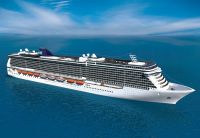
The next generation of ships needs to be of flexible design, according to Giuseppe Torrente, head of the design department at Fincantieri's Merchant Ship Business Unit. He said they need to be energy efficient and economical to operate. "Already more hydrodynamic hull forms require less propulsion power," he explained."The starting point is the speed. By designing hulls for the most frequent speed, we can optimize the hull for that speed and save fuel and energy. A hull optimized for 20 knots will be different from a hull optimized for 22 knots."
In addition the industry has had to work in new stability requirements and the Safe-Return-to-Port concept in their new designs, as well as new ballast water, anti-fouling and recycling conventions, sequentially adopted by the IMO, according to Torrente. The real impact of the new rules and conventions are yet to be determined, he noted, calling it a revolution, not an evolution from past standards.
Pending is the so-called energy efficiency index for which the standards for cruise ships have yet to be defined and agreed upon. Its objective is to contain greenhouse gas emissions.
"As we see it, energy efficiencies will surely be increasingly important in the future," said Olli Jantunen, senior vice president of sales and marketing at STX Finland, and Sami Kouvonen, manager of concept design. Kouvonen is also the naval architect for the dual-fuel Viking Line cruise ferry, designed to run on LNG and being built in Turku.
According to Richard Goodwin, manager of Lloyd's Register's Passenger Ship Support Center, future designs need to be evaluated for their purpose. "There is no need to design and build a race car if what you need is a family car," he commented.
At V.Ships Leisure, Vittorio Facco, technical director responsible for newbuildings, said that diesel electric propulsion is here to stay.
Markus Aarnio, vice president of competence at Foreship, said that other powerplant alternatives are not viable, including solar power, which he called "basically a gimmick." He added that the only choice is between podded propulsion, which generates less noise and vibration, or shaft lines.
Matteo Di Maio, managing director at V.Delta, said the company may take a different view from the big cruise lines, as they mostly work with smaller newbuildings in the luxury, premium and expedition market segments. "For the smaller ships, the choice is between diesel electric propulsion with shaft lines or mechanical propulsion."
According to Facco: "The bottom line is that new ships need to be profitable in order to provide products that the market wants and operate within the financial parameters of the owner. "You cannot design from energy saving perspectives alone."
Putting a brake on inventions and new technology is that something really new would set a ship too far apart from the rest of a fleet, and the cruise line may be forced to retrofit all their other ships, Aarnio explained.
Looking ahead, Fincantieri's Torrente said that someday e-guided vessels may be a reality, using technology to avoid collisions, groundings and other incidents. "Then, we do not have to concentrate on the consequences of flooding if collisions can be avoided," he noted.
Today, cruise ships use AC current, and DC is considered old technology. "But," said Torrente, "progress is being made on DC circuits, breakers, engines, generators and batteries. So never say never."












Recommended Comments
There are no comments to display.
Join the conversation
You can post now and register later. If you have an account, sign in now to post with your account.